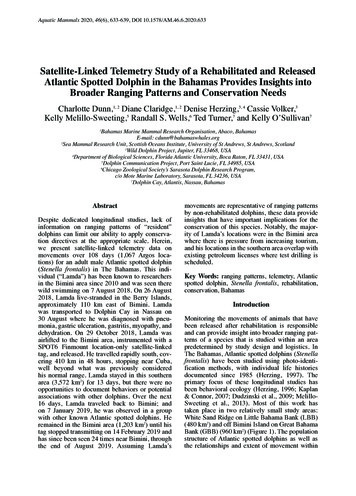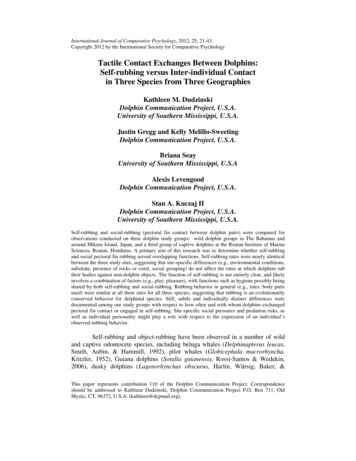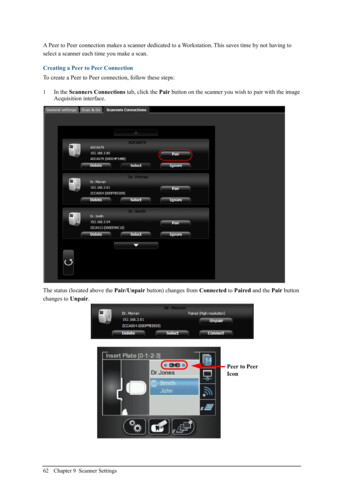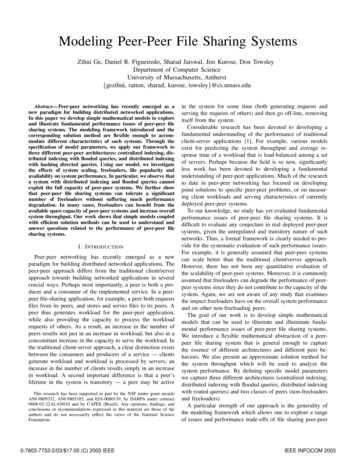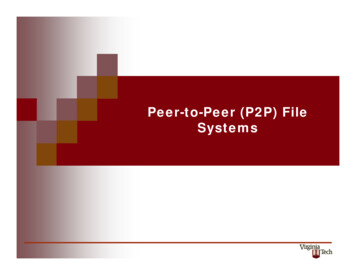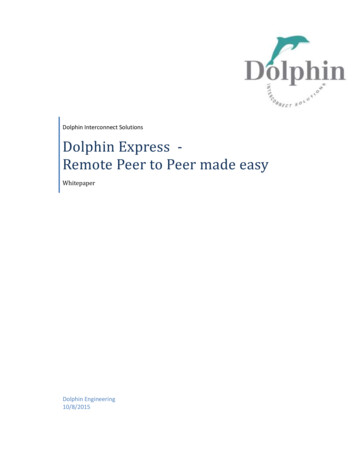
Transcription
Dolphin Interconnect SolutionsDolphin Express Remote Peer to Peer made easyWhitepaperDolphin Engineering10/8/2015
DISCLAIMERDOLPHIN INTERCONNECT SOLUTIONS RESERVES THE RIGHT TO MAKE CHANGES WITHOUTFURTHER NOTICE TO ANY OF ITS PRODUCTS AND DOCUMENTATION TO IMPROVE RELIABILITY,FUNCTION, OR DESIGN. DOLPHIN INTERCONNECT SOLUTIONS DOES NOT ASSUME ANY LIABILITYARISING OUT OF THE APPLICATION OR USE OF ANY PRODUCT OR DOCUMENTS.Page 2Dolphin Express – Remote Peer to Peer made easy
Table of ContentsDISCLAIMER .2Table of Contents .3Introduction .4Hardware configuration.4Connecting computers using PCIe over cable .4Software configuration .5How to make a PCIe address space available for remote access .5How to set up a local PCIe device to access a remote segment or device .5SISCI Source code .5Data transfers .6CPU or DMA engine used for direct remote access .6FPGA direct access to remote memory.6Multicast .6Interrupt forwarding .6Optimized remote interrupt forwarding .6SISCI API .6Availability .7Reference and more information .7Page 3Dolphin Express – Remote Peer to Peer made easy
IntroductionPCIe peer-to-peer communication (P2P) is a part of the PCI Express specification and enables regular PCIExpress devices to establish direct data transfers without the need to use main memory as a temporary storageor use of the CPU for moving data. PCI Express peer to peer communications significantly reduce thecommunication latency but has until now been limited to single systems.The Dolphin Express product family supports P2P communication and enables local PCI Express devices andPCI Express devices located on remote systems to establish P2P communication as if all devices were local. Asingle application can directly control all PCIe devices or parallel applications running on multiple servers canimplement a protocol to share the devices.The Intel Phi, GPUs1, custom FPGAs, specialized data grabbers, video IO Devices etc are devices that typicallywill benefit from exploiting remote P2P communication to reduce latency and communication overhead.Dolphin has integrated support for this functionality into the SISCI API specification to simplify the setup andmanagement of peer to peer transfers. The SISCI software enables applications to use CPU / Programmed IO(PIO) or DMA operations to move data directly to or from local or remote PCI Express devices. It is also possibleto combine the P2P communication with Dolphins reflective memory functionality causing data to be multicastedto multiple devices transparently.The SISCI API was first defined in 1998 and enables customers to easily implement applications to directlyaccess and utilize PCI Express functionality without the need to write device drivers or spend time on studyingPCI Express chipset specifications.Dolphin benchmarks included in the SISCI developers kit show end to end latencies as low as 0.74us and over3500 MegaBytes/sec dataflow at the application level.Hardware configurationThe typical configuration is a modern regular PC with several PCI Express slots. The IO system needs tosupport standard PCI Express peer to peer communication. A DolphinPCIe card is installed in a free PCI Express slot and the device that is tobe connected over PCIe, an FPGA in the example below, is installed inanother PCI Express slot in the same system. Multiple devices can beinstalled in each host.The FPGA board operates in traditional transparent mode. Dependingon the nature of the FPGA and its functionality, the local device driverfor the FPGA board needs to be aware of the remote connectivity andsharing. It is up to the designer of this system to solve any sharingissues that may arise between the local device driver and applicationsaccessing the device from a remote system; the SISCI software justenables the sharing functionality.Connecting computers using PCIe over cableFigure 1 Single node configuration1Two of these systems can be connected directly using a standard PCIExpress cable between the Dolphin adapter cards. Several systems canbe connected by using a Dolphin Express IXS600 PCI Express switch.PCI Express does also support GPU DirectTM functionality.Page 4Dolphin Express – Remote Peer to Peer made easy
Software configurationAll nodes install the standard Dolphin DIS driver softwarepackage. This includes the SuperSockets, The IPoPCIesoftware and the SISCI API. Only the SISCI API will beused to set up the P2P transfers and the customer needsto develop a SISCI application implementing the desiredPCIe peer to peer communication control. The SISCI APIprovides the mechanisms to ease this implementation.Basic SISCI functionality is to allocate parts of the systemmain memory and share it with other cluster nodes.Segments and nodes are identified by a cluster wideunique node IDs and a system wide unique segment IDs.Figure 2 Two nodes interconnected with PCIeApplications use node IDs and segment IDs to realizeconnections. The SISCI and IRM drivers (low level drivers,part of the Dolphin driver package) are responsible for safely managing the resources and low level tasksrequired to establish the connections. NTB mapping tables (LUTs) are set up to perform the local to remoteaddress space translation after appropriate physical addresses are exchanged by the drivers.Each hardware resource made available over PCIe can be mapped into the controlling applications addressspace with the appropriate SISCI API functions. Several applications, possibly running on multiple nodes canshare these devices, but it it’s the responsibility of the application programmer to implement and handle theactual sharing. SISCI provides a rich toolbox for creating clustered applications.How to make a PCIe address space available for remote accessTo register a PCIe device memory as a SISCI segment, application programmers uses theSCIAttachPhysicalMemory() SISCI function to specify the physical address and number of bytes within the PCIedevice that should be made available as a SISCI segment. The application also needs to callSCIPrepareSegment() and SCISetSEgmentAvailable(). After these calls have completed, a remote host canconnect and map to the physical memory.How to set up a local PCIe device to access a remote segment or deviceTo enable a local PCIe device to access a remote SISCI segment (memory or a remote device) you need toidentify the corresponding IO address in the local address space. This address can be retrieved using the SISCISCIQuery() function, flag SCI Q REMOTE SEGMENT IOADDR by the SISCI application after the remotesegment has been connected and mapped. The address returned by the query function can be used directly bythe PCIe master to access the remote segment. The address will be inside the BAR address of the Dolphin PCIecard and directly map to the remote address. The customer must make the address available to the PCIe devicemaster. The address is available after the application has completed the SCIConnectSegment() andSCIMapRemoteSegment() functions.It is also required to register the PCIe device with the Dolphin PCIe card as an approved PCIe master by usingthe SCIRegisterPCIeRequester() SISCI function. This registration will ensure the master access is passingthrough the required NTB function.SISCI Source codePlease review the rpcia.c SISCI test program source code for more details on how to set up a P2P transfer. Theprogram supports both registering a physical device as a segment and to access this from a remote system. Thesource and binaries are included in the software installers.Page 5Dolphin Express – Remote Peer to Peer made easy
Data transfersThe configuration is very flexible and supports concurrent transfers between any of the installed devices andCPU and Memory once the proper connections are established as described above.CPU or DMA engine used for direct remote accessThe figure below visualizes the CPU doing a direct remote access using basic CPU load or store operations.Larger transfers can be accomplished byusing the system bcopy() or moved fromlocal memory to the remote FPGA byengaging the Dolphin PCIe card onboardDMA engine through the appropriateSISCI API function.FPGA direct access to remotememoryAn FPGA device that can act as a PCIemaster can directly place data intoremote memory by using the addressprovide by the SCIQuery() function asdescribed above. (Note that slavedevices may need special designconsideration to achieve the very highsource / sink transfer bandwidths that may be desired. However, this is no different than would be required in asingle root P2P implementation.)MulticastThe SISCI software and Dolphin Express IX and PX cluster using the IXS600 switch installed also supports PCIemulticast functionality – often referenced by Dolphin as “reflective memory”. It is possible to combine PCIemulticast and PCIe peer to peer transfers to enable e.g. an FPGA to send data to multiple targets using a singleposted write transaction. Please find more details on the reflective memory functionality in the Dolphin reflectivememory white paper available from rupt forwardingDevice interrupts, for a device that is accessed from remote, will by default trigger a local interrupt in the systemthat is hosting the card. The local application that is controlling the device can use regular SISCI APISCICreateInterrupt() and SCITriggerInterrupt() to send interrupts to remote nodes.Optimized remote interrupt forwardingDolphin is planning to offer functionality to enable automatic forwarding of MSI interrupts to remote doorbellregisters triggering the SISCI interrupt handler. Please contact Dolphin for further.SISCI APIThe SISCI API (Software Infrastructure Shared-Memory Cluster Interconnect) consists of driver and APIsoftware, tools, documentation and source needed to develop your own embedded application utilizing the lowlatency and high performance of a PCI Express Cluster. The SISCI API provides a C system call interface toease customer integration of PCI Express over cable solutions.Page 6Dolphin Express – Remote Peer to Peer made easy
SISCI enables customer applications to easily and safely bypass the limitations of traditional network solutions,avoiding time consuming operating system calls, and network protocol software overhead. SISCI resources(memory maps, DMA engines, Interrupts etc) are identified by assigned IDs and managed by a resourcemanager enabling portability and independent applications to run concurrently on the same system.The SISCI API has been defined in the European Esprit project 23174 as a de facto industry standardApplication Programming Interface (API) for shared memory based clustering.In addition to the reflective memory/multicast functionality, the SISCI API provides functionality to access remotememory for unicast (single remote read or write) and Direct Remote DMA (RDMA) using the onboard DMAengine. The API also includes support for sending and receiving remote interrupts and error checking.AvailabilityThe PCIe peer to peer functionality described above is available with the Dolphin Express IX and PX products.The functionality is available through the SISCI API using Linux, Windows, VxWorks or RTX operating systems.The nodes can run any of the above operating systems – inter-communication between systems runningdifferent operating systems is fully supported. The number of transparent devices that can be mapped dependson various diver settings and the size of each device. Please contact Dolphin support for more information andtuning recommendations.Reference and more informationPlease visit www.dolphinics.com for additional information.Additional information including the online SISCI API reference manual and SISCI Users guide can be found i-developers-kit.htmlPlease contact pci-support@dolphinics.com if you have any questions.Page 7Dolphin Express – Remote Peer to Peer made easy
Page 4 Dolphin Express - Remote Peer to Peer made easy Introduction PCIe peer-to-peer communication (P2P) is a part of the PCI Express specification and enables regular PCI Express devices to establish direct data transfers without the need to use main memory as a temporary storage or use of the CPU for moving data.
